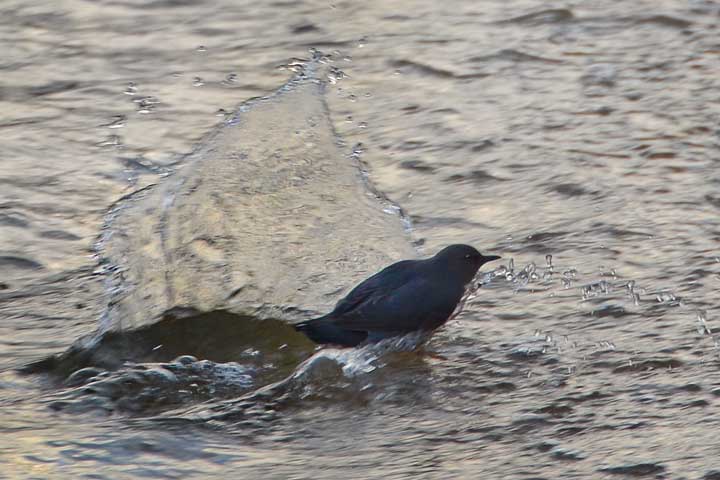This is a detailed discussion of one of the dipper pictures posted on Jan. 3, 2011: the one showing it landing on the lake surface. Explored is the question of whether the dipper is planing (as distinct from floating); in colloquial terms, is the dipper bodysurfing?
The answer is yes, that is what it is doing.
First, the picture, then the discussion.

Most boats (and birds) move over the water in displacement mode: weight is supported by buoyancy (they float); travel is slow; the wake is shaped as a V. When planing, a boat is partially supported by hydrodynamic lift resulting from the engine’s thrust against the water; it travels rapidly, it leaves a narrow wake often with a central mound of water. It takes considerable power to get a boat to plane, and probably a bird would be incapable of swimming fast enough. But, a bird gliding to a landing on water is another matter; it is moving over the surface at a far greater speed than it could swim.
While the dipper in the picture certainly looks as if it were planing, it would be good to see some numbers. To determine if this bird is planing, we should know two things: above what speeds would it be planing; how fast it is actually moving. Estimates of both of these will be made from the picture and known characteristics of American Dippers.
Above what speed would a dipper start planing?
The boundary between the speeds possible for travel in displacement mode and planing is given approximately by the speed of a (deep–water) wave that has a wavelength equal to twice the wetted hull (or body) length. Above this transitional speed, a boat (or bird) is travelling faster than the water waves it excites. The relationship between speed and wavelength for a (deep–water) wave is
c = √(g λ/2π) where c is wave velocity, λ is wavelength, g is gravity
If the wetted part of the dipper (scaled from the picture) is about 7 cm then λ ≈ 0.14 m. This gives the upper bound for displacement swimming for this bird at ≈ 0.5 m/s. Presumably a dipper would have great difficulty even getting up to this speed when swimming and it would never have the power to begin to plane—unless of course it started this way because it was gliding to a landing on water.
How fast is the dipper travelling?
This dipper is gliding to a water landing. Probably the best estimate of its speed is the cruising speed of a dipper. Cruising speed, V, is related to the bird’s wing loading W/S where W is the bird’s weight, and S is its wing area. The relationship is
W/S = 0.38V2
where a typical W for a dipper is about 55 grams and so about 0.55 Newtons. The wing area, S, was scaling from a picture of a dipper wing, and an approximate value of .0065 m2 was obtained. This then gives a cruising speed of ≈ 15 m/s, well above the transition speed for the bird to start to plane.
Conclusion
Even allowing for uncertainty in some of the values, the dipper is clearly planing. This is a bodysurfing birdie.
Notes
• Some statistics for a dipper were obtained from oiseaux-birds.com .
• Dipper wing area was scaled from an image (PSM 17053) posted by the Slater Museum of Natural History, University of Puget Sound.
• The wave velocity of a deep–water wave has been know for over a century and so is found in numerous places.
• The relationship between wing loading and cruising speed is given by Tennekes, The Simple Science of Flight, (1996, MIT Press), p. 6.

I’m afraid I am convinced.
Bodysurfing birdie